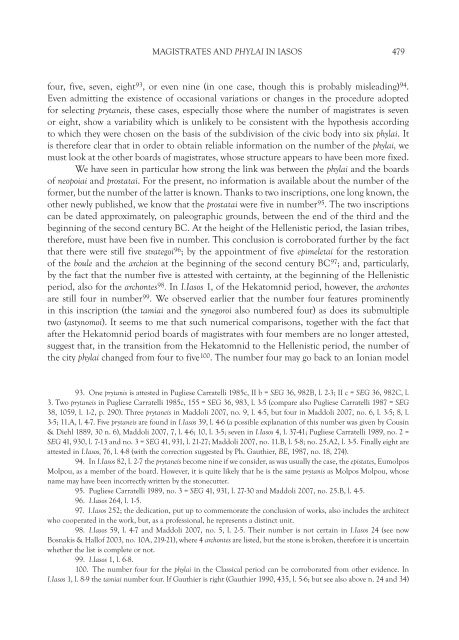hellenistic karia - Associazione Iasos di Caria
hellenistic karia - Associazione Iasos di Caria
hellenistic karia - Associazione Iasos di Caria
You also want an ePaper? Increase the reach of your titles
YUMPU automatically turns print PDFs into web optimized ePapers that Google loves.
MAGISTRATES AND PhylaI IN IASOS 479<br />
four, five, seven, eight 93 , or even nine (in one case, though this is probably mislea<strong>di</strong>ng) 94 .<br />
Even admitting the existence of occasional variations or changes in the procedure adopted<br />
for selecting prytaneis, these cases, especially those where the number of magistrates is seven<br />
or eight, show a variability which is unlikely to be consistent with the hypothesis accor<strong>di</strong>ng<br />
to which they were chosen on the basis of the sub<strong>di</strong>vision of the civic body into six phylai. It<br />
is therefore clear that in order to obtain reliable information on the number of the phylai, we<br />
must look at the other boards of magistrates, whose structure appears to have been more fixed.<br />
We have seen in particular how strong the link was between the phylai and the boards<br />
of neopoiai and prostatai. For the present, no information is available about the number of the<br />
former, but the number of the latter is known. Thanks to two inscriptions, one long known, the<br />
other newly published, we know that the prostatai were five in number 95 . The two inscriptions<br />
can be dated approximately, on paleographic grounds, between the end of the third and the<br />
beginning of the second century BC. At the height of the Hellenistic period, the Iasian tribes,<br />
therefore, must have been five in number. This conclusion is corroborated further by the fact<br />
that there were still five strategoi 96 ; by the appointment of five epimeletai for the restoration<br />
of the boule and the archeion at the beginning of the second century BC 97 ; and, particularly,<br />
by the fact that the number five is attested with certainty, at the beginning of the Hellenistic<br />
period, also for the archontes 98 . In I.<strong>Iasos</strong> 1, of the Hekatomnid period, however, the archontes<br />
are still four in number 99 . We observed earlier that the number four features prominently<br />
in this inscription (the tamiai and the synegoroi also numbered four) as does its submultiple<br />
two (astynomoi). It seems to me that such numerical comparisons, together with the fact that<br />
after the Hekatomnid period boards of magistrates with four members are no longer attested,<br />
suggest that, in the transition from the Hekatomnid to the Hellenistic period, the number of<br />
the city phylai changed from four to five 100 . The number four may go back to an Ionian model<br />
93. One prytanis is attested in Pugliese Carratelli 1985c, II b = SEG 36, 982B, l. 2-3; II c = SEG 36, 982C, l.<br />
3. Two prytaneis in Pugliese Carratelli 1985c, 155 = SEG 36, 983, l. 3-5 (compare also Pugliese Carratelli 1987 = SEG<br />
38, 1059, l. 1-2, p. 290). Three prytaneis in Maddoli 2007, no. 9, l. 4-5, but four in Maddoli 2007, no. 6, l. 3-5; 8, l.<br />
3-5; 11.A, l. 4-7. Five prytaneis are found in I.<strong>Iasos</strong> 39, l. 4-6 (a possible explanation of this number was given by Cousin<br />
& Diehl 1889, 30 n. 6), Maddoli 2007, 7, l. 4-6; 10, l. 3-5; seven in I.<strong>Iasos</strong> 4, l. 37-41; Pugliese Carratelli 1989, no. 2 =<br />
SEG 41, 930, l. 7-13 and no. 3 = SEG 41, 931, l. 21-27; Maddoli 2007, no. 11.B, l. 5-8; no. 25.A2, l. 3-5. Finally eight are<br />
attested in I.<strong>Iasos</strong>, 76, l. 4-8 (with the correction suggested by Ph. Gauthier, BE, 1987, no. 18, 274).<br />
94. In I.<strong>Iasos</strong> 82, l. 2-7 the prytaneis become nine if we consider, as was usually the case, the epistates, Eumolpos<br />
Molpou, as a member of the board. However, it is quite likely that he is the same prytanis as Molpos Molpou, whose<br />
name may have been incorrectly written by the stonecutter.<br />
95. Pugliese Carratelli 1989, no. 3 = SEG 41, 931, l. 27-30 and Maddoli 2007, no. 25.B, l. 4-5.<br />
96. I.<strong>Iasos</strong> 264, l. 1-5.<br />
97. I.<strong>Iasos</strong> 252; the de<strong>di</strong>cation, put up to commemorate the conclusion of works, also includes the architect<br />
who cooperated in the work, but, as a professional, he represents a <strong>di</strong>stinct unit.<br />
98. I.<strong>Iasos</strong> 59, l. 4-7 and Maddoli 2007, no. 5, l. 2-5. Their number is not certain in I.<strong>Iasos</strong> 24 (see now<br />
Bosnakis & Hallof 2003, no. 10A, 219-21), where 4 archontes are listed, but the stone is broken, therefore it is uncertain<br />
whether the list is complete or not.<br />
99. I.<strong>Iasos</strong> 1, l. 6-8.<br />
100. The number four for the phylai in the Classical period can be corroborated from other evidence. In<br />
I.<strong>Iasos</strong> 1, l. 8-9 the tamiai number four. If Gauthier is right (Gauthier 1990, 435, l. 5-6; but see also above n. 24 and 34)



